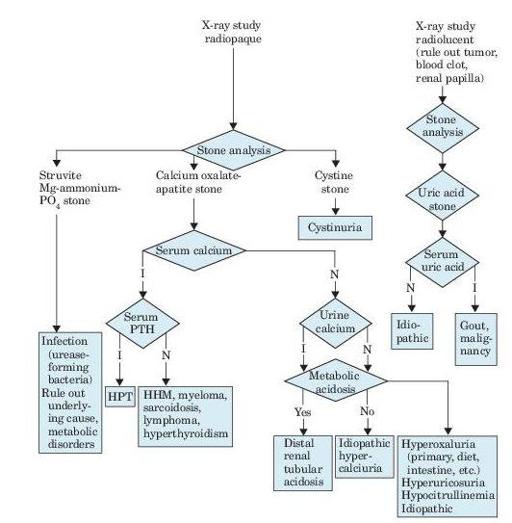Wallach's Interpretation of Diagnostic Tests: Pathways to Arriving at a Clinical Diagnosis (236 page)
Authors: Mary A. Williamson Mt(ascp) Phd,L. Michael Snyder Md

BOOK: Wallach's Interpretation of Diagnostic Tests: Pathways to Arriving at a Clinical Diagnosis
6.49Mb size Format: txt, pdf, ePub
Cystine stones are rare, occurring in patients with homozygous congenital familial cystinuria, and characterized by bilateral obstructive staghorn calculi with associated renal failure.

Figure 7–1
Algorithm for diagnosis of renal calculi, as revealed by flank pain, renal colic, hematuria, fever, and urinalysis findings. I, increased; N, normal; PTH, parathyroid hormone; HPT, hyperparathyroidism; HHM, humeral hypercalcemia of malignancy.
Table 7-1 Comparison of Types of Idiopathic Hypercalciuria

Who Should Be Suspected?
In adults, the most common symptom of calculi that obstruct the ureter or renal pelvis is excruciating, intermittent pain that radiates from the flank to the groin or to the genital area and inner thigh. The pain is commonly accompanied by urinary urgency, restlessness, hematuria, sweating, nausea, and vomiting.
The waves or paroxysms of pain usually last 20–60 minutes and is related to the passage of the stone down the ureter and the associated ureteral spasm.
Flank pain is caused by upper ureteral or renal pelvic obstruction, whereas genital pain is caused by lower ureteral obstruction.
The differential diagnosis of patients with flank pain includes renal bleeding, pyelonephritis, ectopic pregnancy, rupture or torsion of an ovarian cyst, dysmenorrhea, intestinal obstruction, diverticulitis, appendicitis, biliary colic and cholecystitis, and herpes zoster. The intestinal and hepatic causes of flank pain are not accompanied by hematuria nor is a herpes zoster infection (which is usually accompanied by a rash).
Precipitating causes in adults with calculi (20–30%) include destructive bone diseases (either destructive, e.g., metastatic tumors; or osteoporotic, e.g., immobilization, Paget disease, or Cushing syndrome); milk-alkali (Burnett) syndrome; hypervitaminosis D; sarcoidosis; RTA-type I (hypercalciuria, highly alkaline urine, normal serum calcium); hyperthyroidism; and gout (25% of primary cases, 40% of cases with marrow-proliferative disorders).
Precipitating causes in children with calculi include infections (13–40%); hypercalciuria (idiopathic but also caused by distal RTA and therapy with furosemide, prednisone, or ACTH); oxaluria (3–13%); uric acid (4%); cystinuria (5–7%); hypocitraturia (10%); xanthine (an inborn error of metabolism); and adenine phosphoribosyltransferase deficiency.
Laboratory Findings
Two 24-hour urine specimens should be collected and tested for daily volume and levels of magnesium, sodium, uric acid, calcium, citrate, and oxalate.
Other books
El juez de Egipto 2 - La ley del desierto by Christian Jacq
Tek Kill by William Shatner
The Wind Chill Factor by Thomas Gifford
Darla's Story by Mike Mullin
Heart Fortune (Celta) by Owens, Robin D.
Fortune's fools by Julia Parks
At Any Price (Gaming The System) by Aubrey, Brenna
You Don't Even Know Me by Sharon Flake
Mercy Killing (Affairs of State Book 1) by Johnson, Kathryn
Lucky Me by Saba Kapur
